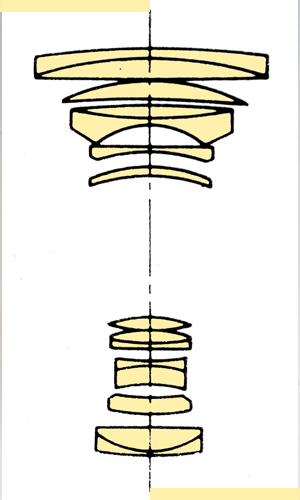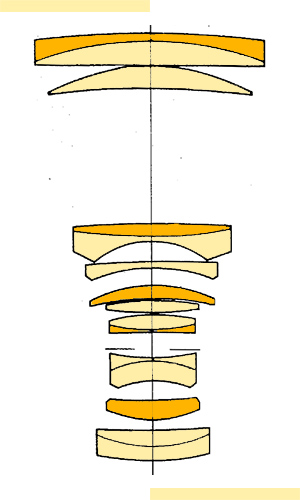The Konica AR 2.8/35-100 mm certainly deserves it place in the history of zoom lenses, even though - technically speaking - it is not a zoom, but a varifocal lens.
After the Voigtländer Zoomar 2.8/36-82 mm and the Nikkor 3.5/43-86 mm - two well known early zoom lenses with disputable reputation - the large and heavy Konica AR 2.8/35-100 mm was an important intermediate step for the development of fast mid-range zooms: It was the first wideangle zoom performing as well as the retrofocus pimes of its time. The optical development of the lens was finished in mid-1968.
The next important step was of course the two-group Canon FD 2.8-3.5/35-70 mm, a true zoom, and an epoch-making construction: finally a small, fast and excellent 35-70mm lens was born. For nearly 15 years, all other fast (f2.8 or f3.5) 35-70mm lenses would be shaped after the original Canon FD 35-70mm project.
Back to the Konica AR 2.8/35-100mm! Weighing 1100 g, the lens is massive. It requires expensive 82 mm filters, and the combination of the lens plus an contemporary Konica T2 SLR would be almost 2 kg. Its build quality is very good, but all three AR 35-100 mm lenses I have seen were a bit worn out. This is understandable, given the fact that the lens was extremely expensive when new (about four times as expensive as the AR 1.8/85mm!) and therefore used by professionals only.
The lens barrel is made of metal, and it doesn't change its length while varying the focal length. Focusing is done by a movement of the entire lens system, without changing the relative position of the three groups. Focusing therefore is quite stiff. The minimum focusing distance varies with the focal length: 1 m at f=100mm, 38 cm at f=50 mm, and 27 cm at f=35 mm. These values, reached without an extra "macro" switch, are excellent - even in the late 1980s it was common for midrange 35-105mm zooms to have a MFD of 1.5 m over the entire zoom range.
Its (for its time) superior performance was achieved by making the lens varifocal. By omiting the compensator group - which usually would keep focusing constant while zooming - the engineers got additional degrees of freedom for correcting the remaining three groups. Tadashi, the optical engineer who has developped the AR 2.8/35-100 mm, did use expensive high refractive glass (nD > 1.8) for five of the fifteen lenses - among them the large front lens. Below are a few excerpts from the original Konica project, showing the glass types used for the 1968 prototype (scroll down).
While Konica claims the lens to perform as well as a (contemporary) prime lens, this may be true in the 35 mm range, but Konica AR 50 mm and 100 mm primes are sharper and have a better contrast than the AR 2.8/35-100mm. Nevertheless, the lens performs much better than the Voigtländer 2.8/36-82 and the original Nikkor 3.5/43-86mm zooms. I have tested three copies of the AR 2.8/35-100mm, on EE and two AE variants. Typical results are shown below, though they differ somewhat from copy to copy (scroll down).
Finally the prices: They are extremely variable. My first sample, bought about five years ago, was about CHF 250.--, the second one, bought two years ago, came for CHF 80.--, and the third one (rubber of the focusing ring missing!) was found on a local flea market for CHF 7.--.
 |
 |
KONICA HEXANON 35-100mm 1:2.8 Varifocal (15 Linsen / 10 Gruppen)
|
 |
 |
KONICA HEXANON 35-100mm 1:2.8 Varifocal (15 Linsen / 10 Gruppen)
|
|
Lens 1: nD=1.805, v=25.5 Lens 2: nD=1.640, v=60.2 Lens 3: nD=1.620, v=60.3 Lens 4: nD=1.805, v=25.5 Lens 5: nD=1.670, v=47.2 Lens 6: nD=1.620, v=60.3 Lens 7: nD=1.805, v=25.5 Lens 8: nD=1.620, v=60.3 Lens 9: nD=1.640, v=60.2 Lens 10: nD=1.805, v=25.5 Lens 11 nD=1.697, v=55.6 Lens 12: nD=1.717, v=29.5 Lens 13: nD=1.805, v=41 Lens 14: nD=1.755, v=52.4 Lens 15: nD=1.755, v=27.5 |
KONICA HEXANON 35-100mm 1:2.8 Varifocal prototype lens 1968 |
Above: 100% crops from 24 MP FF camera, showing the extreme corners at f=35mm and f2.8, f5.6, and f11, respectively.
Above: 100% crops from 24 MP FF camera, showing the extreme corners at f=50mm and f2.8, f5.6, and f11, respectively.
Above: 100% crops from 24 MP FF camera, showing the extreme corners at f=100mm and f2.8, f5.6, and f11, respectively.





